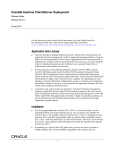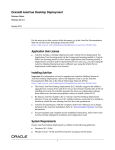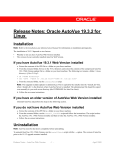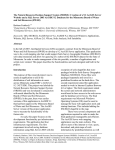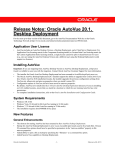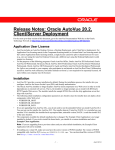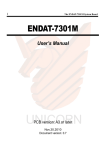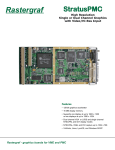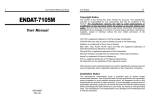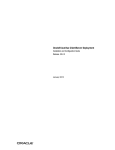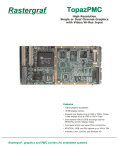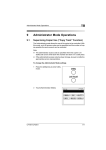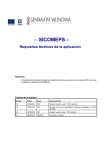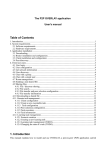Download avfaa - Oracle Documentation
Transcript
Oracle® AutoVue for Agile PLM Release Notes Release 20.2.3 Part Number E60384-03 June 2015 For the most up-to-date version of this document, go to the Agile Documentation Web site on the Oracle Technology Network (OTN) http://www.oracle.com/technetwork/documentation/agile-085940.html. Application User License ■ ■ ■ AutoVue includes a Desktop Deployment and a Client/Server deployment. For Application User licensing metric (in the Component licensing model) or Custom Suite User licensing metric (in the Custom Applications Suite licensing model), a single license cannot be split or shared between two users (e.g., one user using the AutoVue Desktop Deployment and a different user using the Client/Server deployment would require two licenses). For the purposes of the following programs: Oracle AutoVue Office, Oracle AutoVue 2D Professional, Oracle AutoVue 3D Professional Advanced, Oracle AutoVue EDA Professional, Oracle AutoVue Electro-Mechanical Professional, Oracle AutoVue 2D Professional for Agile and Oracle AutoVue Electro-Mechanical Professional for Agile a user external to your company who participates in and attends an AutoVue Real-Time Collaboration session or AutoVue web conference, but neither initiates nor hosts it, is not required to be separately licensed. All users within your company must be licensed. Customers who wish to make use of Oracle's AutoVue Enterprise Visualization solutions within their Oracle Agile PLM environment must use the AutoVue for Agile visualization products, as they have been specifically designed to work with Oracle Agile PLM. The appropriate AutoVue for Agile visualization products can be downloaded from the Oracle Software Delivery Cloud under Oracle Agile Applications product packs. Installation ■ ■ If you are upgrading from AutoVue for Agile PLM 20.1.x/20.2.x, you do not need to run the uninstaller before you install AutoVue for Agile PLM 20.2.3. You can just run the installer for AutoVue for Agile PLM 20.2.3. The installer detects if AutoVue for Agile PLM 20.1.x/20.2.x is installed on your machine. If it is installed, the installer backs up required data, uninstalls version 20.1.x/20.2.x and then installs 20.2.3 to the same location. However, if you already have 20.2.x, with codebase (client JAR files) set in Jetty, the installer will upgrade to AutoVue for Agile PLM 20.2.3. If installing on a Oracle Linux OS, make sure you have the correct version of WINE installed. The version of WINE compatible with AutoVue for Agile PLM 1 20.2.3 is wine-av-20040914-24.i386.rpm. You can download this version of WINE from http://oss.oracle.com/AutoVue. ■ ■ ■ ■ If installing on a Oracle Linux 6.X OS, run the YUM update agent on your Oracle Linux distribution to download the latest Xvfb and Mesa packages. If the Xvfb version is incorrect, 3D files may not display. For Oracle Linux 5.X install Xvfb version 6.8.2 or later. Make sure you install the Xvfb with XRender and GLX extensions. Refer to the Oracle AutoVue for Agile PLM Installation Guide for more information. When upgrading AutoVue for Agile PLM, if the client and server versions do not match, AutoVue for Agile PLM displays an error message indicating the incompatibility. Ensure that the client jars are upgraded in all codebase locations after you upgrade the server. AutoVue for Agile PLM documentation, with the exception of the User's Manual, are no longer included in the AutoVue for Agile PLM installation. Refer to "Documentation Updates" on page 1-6 for more information. For pre-requisites and complete installation instructions, refer to the AutoVue for Agile PLM Installation Guide. System Requirements The system requirements for AutoVue for Agile PLM are provided in the following table: Table 1 System Requirements Components Oracle-Certified Operating Systems and Software AutoVue Server1 Windows (The installation requires about 400MB of free space. Additional space will be required by AutoVue for storing other data such as streaming files and markups.) ■ Windows Server 2008 - 32-bit - 64-bit (AutoVue running in 32-bit mode) ■ Windows Server 2008 R2 - 64-bit (AutoVue running in 32-bit mode) Important: Windows 2008R2 has improved memory management compared to Windows 2008. It is recommended that you run AutoVue on Windows 2008R2 for better memory handling and long-term stability. ■ Windows Server 2012 - 64-bit (AutoVue running in 32-bit mode) 2 Table 1 (Cont.) System Requirements Oracle-Certified Operating Systems and Software Components Linux ■ Oracle Linux 5.8 and up (x86) and 6.X (x86) - 64-bit (AutoVue running in 32-bit mode) ■ Red Hat Enterprise Linux 5.8 and up (x86) and 6.X (x86) - 64-bit (AutoVue running in 32-bit mode) Important: AutoVue is supported on a 64-bit Linux operating systems (OS), but will run in 32-bit mode. The following prerequisites libraries should be in 32 bit, with the exception the Xvfb package xorg-x11-server-Xvfb. These should be the same architecture (64-bit) as the OS: ■ libGL.so.1 ■ libGLU.so.1 ■ libz.so.1 ■ libbz2.so.1 ■ libXt.so ■ libXp.so Virtualization ■ Oracle Virtual Machine 2.2.2 ■ VMWare Server version ESXi 5 Client Windows OSes: Clients running the following Java Virtual Machines: Windows XP—32-bit and 64-bit ■ Java SE 7 update 45 and higher - 32-bit and 64-bit ■ Java SE 8 update 11 and higher - 32-bit and 64-bit Windows Vista—32-bit and 64-bit Windows 7—32-bit and 64-bit Windows 8—32-bit and 64-bit ■ Internet Explorer 7 ■ Internet Explorer 8 ■ Internet Explorer 9 ■ Internet Explorer 10 ■ Firefox ESR 24 ■ Chrome 21 MAC OS X 10.8 ■ Safari 5.02 ■ Firefox ESR 24 Solaris 10 (Sparc) ■ 3 Firefox ESR 24 Table 1 (Cont.) System Requirements Components Oracle-Certified Operating Systems and Software Application Server ■ Tomcat 6.x and up ■ Oracle Solaris (SPARC and x64) ■ Linux (Oracle, Red Hat Enterprise, SUSE) ■ Microsoft Windows ■ HP-UX Itanium ■ IBM AIX (POWER) The VueServlet has been certified on the following application servers: AutoVue for Agile PLM AutoVue for Agile PLM integration components can be installed on the following OSes: For supported versions, refer to the "Agile Product Lifecycle Management Capacity Planning Guide" on OTN http://www.oracle.com/technetwork/docume ntation/agile-085940.html 1 2 The AutoVue server can be installed on a different platform than the AutoVue for Agile PLM integration components. When launching AutoVue from a Mac client, certain configurations may be required. For more information, refer to Oracle Support Document 1662405.1 (Getting Message "Select a temporary directory" When Printing With AutoVue) which can be found at: https://support.oracle.com/epmos/faces/DocumentDisplay?id=1662405.1 Integrations with AutoVue for Agile The following integrations have been certified with AutoVue for Agile: ■ Agile PLM 9.3.4, 9.3.3, and 9.3.2 General Enhancements ■ The AutoVue server requires authentication by default. Valid types of authentication are through a DMS or using an authenticator plug-in (for example, Kerberos). If AutoVue is installed standalone (that is, not integrated with a DMS or if an authenticator plug-in is not configured), then users are not able to connect to the server. The system administrator can modify this behavior by setting jvueserver.authentication.enable in jvueserver.properties to FALSE. However, Oracle recommends to set this parameter to TRUE in order to prohibit all unauthenticated connections to the AutoVue server. For more information on jvueserver.authentication.enable, refer to "New jvueserver.properties Options." ■ The AutoVue applet/window title bar displays the document filename followed by the AutoVue window name: <filename> - AutoVue <Main|Secondary> Window This makes it easier and quicker to find the AutoVue window containing a particular document. Note: If the AutoVue applet is embedded in an HTML page, the AutoVue applet window name does not appear in the title bar. 4 ■ ■ ■ ■ ■ AutoVue client components (jvue.jar, jogl.jar and gluegen-rt.jar) include the Trusted-Library manifest attribute to satisfy the changes made in Java 7 Update 21 (7u21). If you use customized JAR files, you must set the Trusted-Library manifest attribute in the customized JAR files when deploying on Java 7u21 or later. A Print Progress dialog has been added for Batch Printing. This dialog allows users to see which documents are queued for printing, cancel printing of specific documents, and see the status of all documents queued for printing. Resizing the AutoVue window when an image in the workspace has been zoom fitted (Horizontal, Vertical or Both) results in the proportional resizing of the image. This allows users to freely rearrange and resize AutoVue windows without having to zoom fit the contents of each window. Users can now print Markup Notes from the Note dialog. allowing them to easily print single or multiple comments from a document with multiple Markup Notes. The PDF Conversion feature of AutoVue now produces searchable text. This allows sharing of searchable documents with external users who do not have access to AutoVue. Linux-Specific Enhancements ■ To ensure that temporary files are created in a secure location on Linux, the default value setting of the AutoVue temporary directory – TMPDIR – has been set to "/tmp/autovue", and its permission is set to 700. Unix permission 700 only allows the owner of the folder to have full (read/write/edit access). The AutoVue server administrator is responsible for ensuring that the environment variable follows security guidelines. For more information refer to Oracle AutoVue Installation and Configuration Guide. Format Enhancements The section lists format enhancements. MCAD Formats ■ Added support for SolidWorks 2014 ■ Added support for Solid Edge ST6 ■ Enhanced support for SolidWorks - AutoVue supports custom attributes for SolidWorks 3D files. - AutoVue displays a warning message when loading a SolidWorks 2D file that does not contain any display data. AEC Formats ■ When a DWF 3D file attribute name has more than one attribute value, AutoVue displays both attributes in the Attributes tab of the Entity Properties dialog. The second attribute value is preceded by the "(native)" string. EDA Formats ■ Added support for Altium Designer 10 5 Desktop/Office Formats ■ ■ Added support for Adobe Acrobat XI (11) When viewing an Adobe PDF document, the mouse wheel can be used to perform the following actions: - Multi-page document: The mouse wheel scrolls through the document. - Single-page document: The mouse wheel zooms in and out of the document. Documentation Updates All the documents can be found on the Agile Documentation Web site on the Oracle Technology Network (OTN) http://www.oracle.com/technetwork/documentation/agile-085940.html. New JVue API Parameter Refer to the JavaDocs for more information. Table 2 New JVue API Parameter Parameter Description isPrinting() Returns TRUE if the current window or any of its child windows are running batch printing. New jvueserver.properties Options The following are new options that can be set in jvueserver.properties file located in the <AutoVue Installation folder>\bin directory. For more information on these options, refer to the Oracle AutoVue Client/Server Deployment Installation and Configuration Guide: Table 3 jvueserver.properties Options Parameter Description Default jvueserver.profile.markups.filter= [CONSOLIDATE_ OPENASACTIVE|RESCALEMA RKUP|SIGNOFF|SYMBOLLIST |ANGLESYMBOLLIST|ATTAC HMENT_ SIZE|ARCSSYMBOLLIST|DIST ANCESYMBOL|AREASYMBOL LIST...] This option allows administrators to SIGNOFFFILE define which INI options under the [MARKUP OPTIONS] sections cannot be modified using JavaScript. The option takes a regular expression string. Example: The default value for the option is "SIGNOFFFILE", which means that SIGNOFFFILE cannot be modified using JavaScript. jvueserver.authentication.enable= Specify whether authentication is [TRUE|FALSE] enabled for the AutoVue server. Oracle recommends to prohibit all unauthenticated connections to the AutoVue server. Oracle recommends to set this parameter to TRUE in order to prohibit all unauthenticated connections to the AutoVue server. 6 TRUE Updated jvueserver.properties Options The following are jvueserver.properties options that have been updated: ■ xvfb.args: Default value has changed to -nolisten tcp -cc 4 -screen 0 1280x1024x24 -pixdepths 1 8 15 16 New INI File Settings INI options described in following sections should be set in user INI files. File Open/File Browse Dialog INI Option All the options described in the following table should be placed under the [OPTIONS] header in the INI file: Table 4 File Open/File Browse Dialog INI Options Parameter Description UFCSETTINGS= <int, int, int, int, [0|1], int, int> Specify customization parameters for the File Open dialog. Syntax: <top-left-x-position>,<top-left -y-position>,<width>,<height >,<view-type>,<column1-wid th>,<column2-width>,...,<colu mnN-width> For <view-type>, accepted values are: 0: List view 1: Detailed view Note: The <columnN-width> fields are optional. BROWSESETTINGS= <int, int, Specify customization int, int, [0|1], int, int> parameters for the File Browse dialog. Syntax: <top-left-x-position>,<top-left -y-position>,<width>,<height >,<view-type>,<column1-wid th>,<column2-width>,...,<colu mnN-width> For <view-type>, accepted values are: 0: List view 1: Detailed view Note: The <columnN-width> fields are optional. 7 Default Deprecated INI Options The following INI options have been deprecated1: ■ RESOLVERESOURCES ■ USERXREFPATHS ■ USERXFONTPATHS ■ SESSIONXREFPATHS ■ SESSIONXFONTPATHS ■ XREFPATHS Deprecated File Formats/Versions Oracle AutoVue has deprecated support for some file formats/versions, which had very limited usage and low demand from our customers. This will allow Oracle AutoVue to focus development efforts on formats which are most strategic to our customers. The following formats/versions have been deprecated and will be removed in a future release. AEC Formats ■ SmartSketch Note: As this format will be de-supported in a future release, it is recommended to convert to AutoCAD instead. MCAD Formats ■ ■ Support for AutoDesk Inventor IDV and IDE files has been deprecated. AutoVue will continue to support AutoDesk Inventor IPT and IAM files. AutoVue Assembly Format Note: As this format will be de-supported in a future release, it is recommended to convert to CATIA V4 or DirectModel (JT) assembly files (depending on whether the part files are CATIA or JT) instead. ■ CoCreate Modeling / SolidDesigner / OneSpace Designer Modeling Note: As this format will be de-supported in a future release, it is recommended to convert to STEP instead 1 Deprecated options/features/formats/versions should be avoided as they will be de-supported in a future release. However, they are still supported in this release of AutoVue for Agile PLM. 8 ■ CATIA V4 2D Note: As this format will be de-supported in a future release, it is recommended to convert to CATIA V5 2D instead. CATIA V4 3D will continue to be supported. ■ PLM XML Note: As this format will be de-supported in a future release, it is recommended to convert to DirectModel (JT) assembly files instead. ■ Unigraphics NX 2D Note: As this format will be de-supported in a future release, it is recommended to convert to AutoCAD instead. Unigraphics NX 3D will continue to be supported. Deprecated and De-supported Functionality AutoVue for Agile PLM will no longer support some of its functionalities which had very limited usage and low demand from our customers. This will allow AutoVue for Agile PLM to focus development efforts on functionalities which are more important to our customers. The following functionalities are de-supported/deprecated in this release: ■ ■ ■ JXTA protocol is no longer supported. As a result, support for the following JXTA-based collaboration parameters has been removed: - jvueserver.collaboration.tcp.port - jvueserver.collaboration.group - jvueserver.collaboration.protocol - jvueserver.collaboration.rendezvous.enable - jvueserver.collaboration.rendezvous - jvueserver.collaboration.config.manual - jvueserver.connection.jxta.tcp.enable - jvueserver.connection.jxta.http.enable - jvueserver.collaboration.jxta.allowExternal - jvueserver.collaboration.http.server - jvueserver.collaboration.tcp.server - Logger class: com.cimmetry.jvueserver.collaboration.jxta Due to improvements in AutoVue printing, NATIVEJAVAPRINTING INI option has been de-supported. It is recommended to use the correct extensions for all formats. In a future release, AutoVue will only open files with the correct/supported file extensions. 9 ■ Support for the uploading with XREFs feature has been deprecated. It is recommended to upload a ZIP file that includes the base file and associated XREFs. Note: This only impacts files that are opened from a local disk. Files that are accessed through an integration to a repository are not affected. ■ ■ ■ ■ ■ USERNAME AutoVue applet parameter and associated getUserName() JVue API function have been deprecated. Support for non-geometric Product Manufacturing Information (PMI) has been deprecated. AutoVue will continue to support: - Coordinate system - Datum target - Dimension - Feature Control Frame - Line Weld - Note Support for conversion of 3D pages to STL and Raster formats has been deprecated. Support for native 2D Creo Parametric (Pro/Engineer) data will be removed in a future release. To correctly display 2D Creo Parametric (Pro/Engineer) files when native 2D support is removed, it is recommended to set the "save_display" configuration to "yes" in the native application. Support for Mockup through the UI has been deprecated. De-supported Platform ■ ■ Windows Server 2003 OS is not longer supported. 32-bit support for Windows XP, Vista, 7 and 8 has been deprecated and will be removed in a future release Known Issues For information on known issues, go to My Oracle Support (http://support.oracle.com) and then either browse the Knowledge Management (KM) notes under the Knowledge tab, or enter a query in the Search Knowledge Base field. AutoVue for Agile PLM Release Notes, Release 20.2.3 Copyright © 1999, 2015 Oracle and/or its affiliates. All rights reserved. Portions of this software Copyright 1996-2007 Glyph & Cog, LLC. Portions of this software are owned by Siemens PLM © 1986-2012. All rights reserved. This software uses ACIS® software by Spatial Technology Inc. ACIS® Copyright © 1994-2008 Spatial Technology Inc. All rights reserved. Oracle is a registered trademark of Oracle Corporation and/or its affiliates. Other names may be trademarks of their respective owners. This software and related documentation are provided under a license agreement containing restrictions on use and disclosure and are protected 10 by intellectual property laws. Except as expressly permitted in your license agreement or allowed by law, you may not use, copy, reproduce, translate, broadcast, modify, license, transmit, distribute, exhibit, perform, publish or display any part, in any form, or by any means. Reverse engineering, disassembly, or decompilation of this software, unless required by law for interoperability, is prohibited. The information contained herein is subject to change without notice and is not warranted to be error-free. If you find any errors, please report them to us in writing. If this software or related documentation is delivered to the U.S. Government or anyone licensing it on behalf of the U.S. Government, the following notice is applicable: U.S. GOVERNMENT RIGHTS Programs, software, databases, and related documentation and technical data delivered to U.S. Government customers are "commercial computer software" or "commercial technical data" pursuant to the applicable Federal Acquisition Regulation and agency-specific supplemental regulations. As such, the use, duplication, disclosure, modification, and adaptation shall be subject to the restrictions and license terms set forth in the applicable Government contract, and, to the extent applicable by the terms of the Government contract, the additional rights set forth in FAR 52.227-19, Commercial Computer Software License (December 2007). Oracle USA, Inc., 500 Oracle Parkway, Redwood City, CA 94065. This software is developed for general use in a variety of information management applications. It is not developed or intended for use in any inherently dangerous applications, including applications which may create a risk of personal injury. If you use this software in dangerous applications, then you shall be responsible to take all appropriate fail-safe, backup, redundancy and other measures to ensure the safe use of this software. Oracle Corporation and its affiliates disclaim any liability for any damages caused by use of this software in dangerous applications. This software and documentation may provide access to or information on content, products and services from third parties. Oracle Corporation and its affiliates are not responsible for and expressly disclaim all warranties of any kind with respect to third party content, products and services. Oracle Corporation and its affiliates will not be responsible for any loss, costs, or damages incurred due to your access to or use of third party content, products or services. 11 12












